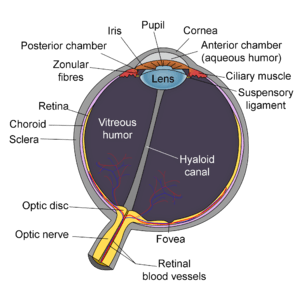Microspherophakia
Microspherophakia is a rare congenital autosomal recessive condition where the lens of the eye is smaller than normal and spherically shaped. This condition may be associated with a number of disorders including Peter's anomaly, Marfan syndrome, and Weill–Marchesani syndrome.[1] The spherical shape is caused by an underdeveloped zonule of Zinn, which doesn't exert enough force on the lens to make it form the usual oval shape.[2] It is a result of a homozygous mutation to the LTBP2 gene.[3]
| Microspherophakia | |
|---|---|
 | |
| Schematic diagram of the human eye(normal) | |
| Specialty | Ophthalmology |
See also
References
- "Spherophakia". University of Arizona. Retrieved 2012-08-20.
- Nirankari, M.S.; Maudgal, M.C. (1959). "Microphakia" (PDF). British Journal of Ophthalmology. 43 (5): 314–316. doi:10.1136/bjo.43.5.314. PMC 509814. PMID 13651569.
- Kumar et al. (October 2010). "A homozygous mutation in LTBP2 causes isolated microspherophakia". Human Genetics. 128 (4): 365–371. doi:10.1007/s00439-010-0858-8. PMID 20617341.CS1 maint: uses authors parameter (link)
Further reading
External links
| Classification |
|---|
This article is issued from Wikipedia. The text is licensed under Creative Commons - Attribution - Sharealike. Additional terms may apply for the media files.